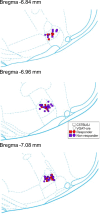Central amygdala-to-pre-Bötzinger complex neurotransmission is direct and inhibitory
- PMID: 39498665
- PMCID: PMC11612842
- DOI: 10.1111/ejn.16589
Central amygdala-to-pre-Bötzinger complex neurotransmission is direct and inhibitory
Abstract
Breathing behaviour is subject to emotional regulation, but the underlying mechanisms remain unclear. Here, we demonstrate a direct relationship between the central amygdala, a major output hub of the limbic system associated with emotional brain function, and the brainstem pre-Bötzinger complex, which generates the fundamental rhythm and pattern for breathing. The connection between these two sites is monosynaptic and inhibitory, involving GABAergic central amygdala neurons whose axonal projections act predominantly via ionotropic GABAA receptors to produce inhibitory postsynaptic currents in pre-Bötzinger neurons. This pathway may provide a mechanism to inhibit breathing in the context of freezing to assess threats and plan defensive action. The existence of this pathway may further explain how epileptic seizures invading the amygdala cause long-lasting apnea, which can be fatal. Although their ultimate importance awaits further behavioural tests, these results elucidate a link between emotional brain function and breathing, which underlies survival-related behaviour in mammals and pertains to human anxiety disorders.
Keywords: SUDEP; anxiety; central amygdala; defense; pre‐Bötzinger complex; respiration.
© 2024 The Author(s). European Journal of Neuroscience published by Federation of European Neuroscience Societies and John Wiley & Sons Ltd.
Conflict of interest statement
The authors have no financial or other conflicts of interest to declare.
Figures



References
-
- Adke, A. P. , Khan, A. , Ahn, H. S. , Becker, J. J. , Wilson, T. D. , Valdivia, S. , Sugimura, Y. K. , Martinez Gonzalez, S. , & Carrasquillo, Y. (2021). Cell‐type specificity of neuronal excitability and morphology in the Central Amygdala. eNeuro, 8(1), ENEURO.0402‐20.2020. 10.1523/ENEURO.0402-20.2020 - DOI - PMC - PubMed
-
- Bagur, S. , Lefort, J. M. , Lacroix, M. M. , de Lavilléon, G. , Herry, C. , Chouvaeff, M. , Billand, C. , Geoffroy, H. , & Benchenane, K. (2021). Breathing‐driven prefrontal oscillations regulate maintenance of conditioned‐fear evoked freezing independently of initiation. Nature Communications, 12, 2605. 10.1038/s41467-021-22798-6 - DOI - PMC - PubMed
MeSH terms
Substances
Grants and funding
LinkOut - more resources
Full Text Sources

